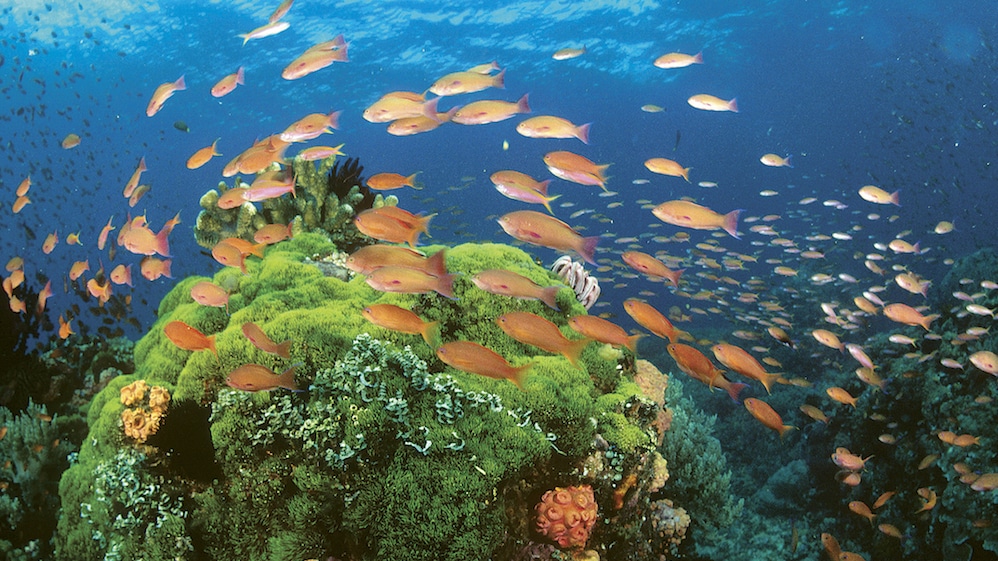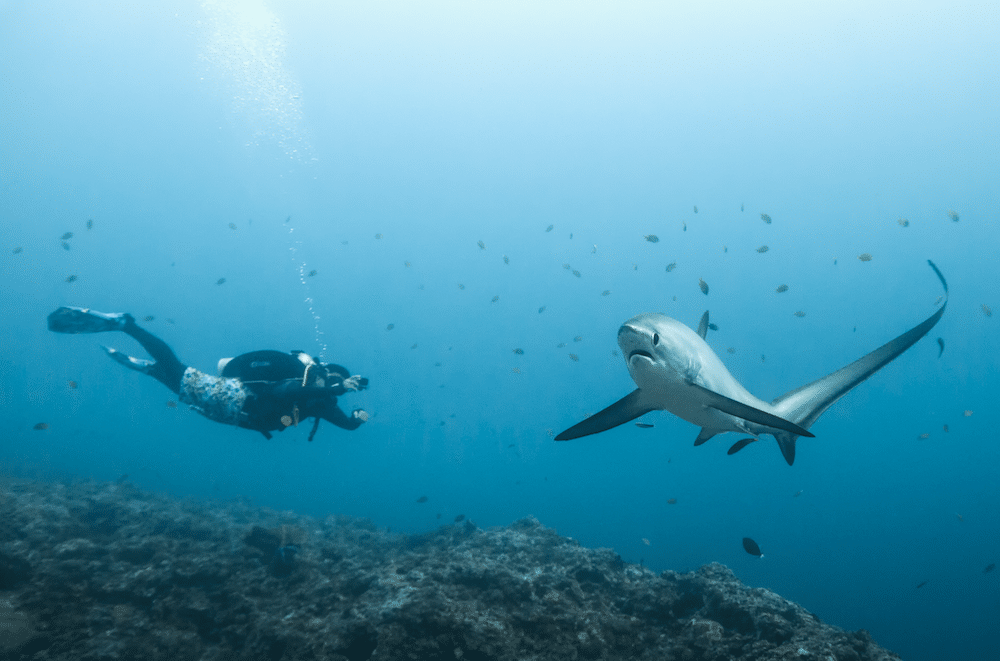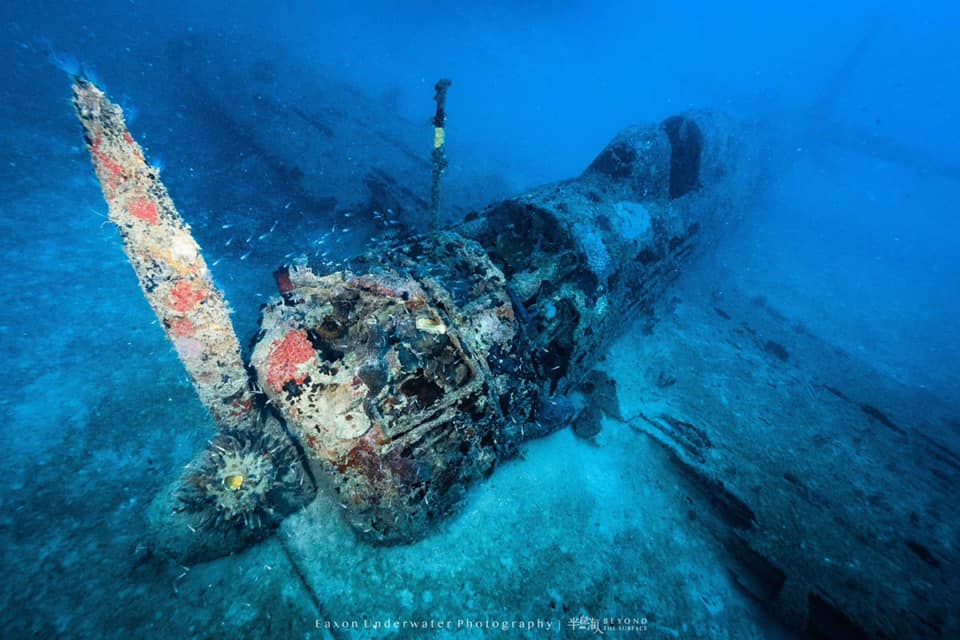News
These 8 Dive Spots in the Philippines are known to be the best in Asia

The Philippines has, once again, been declared as Asia’s Leading Dive Destination by the 28th World Travel Awards. This is now the third consecutive year that the country won this title. It has undeniably some of the best diving spots in Asia, with adventures that await beginners and professional divers who want to experience the thrill of roller-coaster drift dives. Underwater photography enthusiasts will enjoy documenting the diverse marine life that thrives in the clear tropical waters.
The archipelagic state is part of the heart of the Coral Triangle, the world’s center of marine biodiversity. It has the third-largest area of coral reef in the world at 25,060 km2 that is home to 75% of the world’s coral species and an abundant biodiversity that includes 3,000 species of fish. The government, environmental organizations, and local residents are working together to protect this rich marine biodiversity.
“We are very happy that the country’s mesmerizing dive spots remain the best among Asia in the recent 2021 World Travel Awards. On behalf of the Philippines Department of Tourism and our tourism workers and stakeholders, we thank everyone who voted for the Philippines. We will continue to protect and preserve our seas and marine wildlife so that more people can witness our rich and mesmerizing underwater resources,” said Tourism Secretary Berna Romulo-Puyat.
The Philippines is a vibrant, colorful country and this extends to the marine life that is thriving under its seas. More Fun Awaits in the Philippines as the Philippines Department of Tourism is preparing its popular diving sites and at the same time developing its new dive attractions and circuits that promote sustainable tourism. Health protocols are also being put into place at each destination for the safety of travelers while showcasing the breathtaking beauty of the Philippine seas.
In fact, The Department of Tourism (DOT) has announced the vaccination of more than 95% of tourism workers employed in accredited dive establishments across the Philippines, signalling the readiness of this niche market to the eventual reopening of the country to foreign visitors.
Get ready to dive into these amazing underwater spots waiting for your visit when international travel resumes.
- Tubbataha Reef, Puerto Princesa
The Tubbataha Reefs Natural Park is a UNESCO World Heritage Site which is said to be one of the country’s oldest ecosystems. It covers 96,828 hectares of underwater adventures. This atoll reef has a very high density of marine biodiversity, with more than 700 fish species, over 360 coral species, 11 shark species, and 13 dolphin and whale species already been recorded, and its North Islet serving as a nesting site both for birds and two species of endangered marine turtles – the green turtles and hawksbill turtles. The site has a spectacular 100-m perpendicular wall, extensive lagoons and two coral islands, with exciting pelagic action involving white tip reef sharks, manta rays, and whale sharks.
- Anilao, Batangas
Anilao, in the Municipality of Mabini, is located just a short drive away from the Philippines’ capital of Manila. This has made it a haven for weekend diving enthusiasts from the city, especially those who are into underwater photography. It is located along the Verde Island Passage between Batangas and Mindoro, which is considered as the center of marine shore fish biodiversity with 319 species swimming in its blue waters that coral taxonomist Douglas Fenner says is home to 74 genera of hard corals. Anilao is a destination for both macro and muck diving enthusiasts, with rare critters like rhinopias, and colorful nudibranchs. It is also a perfect place to perfect blackwater and bonfire diving skills in macrophotography.
- Dauin and Apo Island Dumaguete
The Municipality of Dauin has many dive spots for different levels of enthusiasts. These spots are protected marine sanctuaries that look after the sea’s biodiversity. Dauin is a big draw for those who are into muck diving, owing to the fascinating tiny creatures that dwell camouflaged along the corals, sea grass, and rock formations. Exciting sightings can start close to the shoreline, and these include different kinds of pipefishes, razorfish, frogfishes, sea horses, wasp fishes, snake eels, sea moths, dragonettes, flounders, snappers, stargazers, and crabs and turtles.
A scenic 30-minute boat ride from Dumaguete brings divers to Apo Island, a marine sanctuary organized by its local community. It offers myriad opportunities to explore on the ground with its volcanic rock formations, and undersea where 400 coral species where over 650 species of fish reside. There is a community of sea turtles that don’t mind swimming serenely alongside divers and having these awesome moments captured on camera. For a feeling of exclusivity, book a stop at the Marine Sanctuary found southeast off of Apo Island, where only 100 divers are allowed per day to preserve its ecological balance.
- Apo Reef Natural Park, Occidental Mindoro
Apo Reef is the largest atoll-like coral reef in the Philippines. Covering an area of 34 square kilometers, it is the second largest connecting coral reef in the world after the Great Barrier Reef of Australia. The pristine waters of the 30-meter deep channel are teeming with 385 species of fish have been identified in the area, including angel fishes, parrot fishes, jacks, and trevallies. Divers can also encounter reef sharks, moray, giant squid and giant clams. It has a mangrove forest which serves as source of food, spawning ground, and sanctuary of several marine and bird species.
Among that activities available for travelers are scuba diving, snorkeling, kayaking, lagoon rafting, and watching the birds, dolphins and turtles that abound in the area.
- Puerto Galera, Mindoro and Verde Island
The name Puerto Galera is Spanish for Port of the Galleons for the trading vessels that would anchor off its shores of this place. Today, it is popular for its numerous diving spots as part of the Verde Island Passage of the Coral Triangle of Asia. Its clear waters allow for high visibility that is perfect for diving among the hard and soft varieties of corals that house about 60 percent of the world’s shore fish. Puerto Galera is part of the Dive and Drive tourism circuit that has been developed by the Department of Tourism that includes important dive sites like Ticao Island in Masbate and Anilao in Batangas.
If the Coral Triangle is considered as the underwater Amazon Forest, Verde Island is at the center of its heart. The Verde Island Wall –two rocks jutting out southeast of the island is considered as the best dive sites in the Philippines, with excellent visibility and lot so nooks and crannies to explore. Colorful corals are home and playground to white tips and other sharks, mantas, tuna and jacks with pelagics like parrotfish, unicorn fish, and Napoleons adding even more color to the visual impact of clouds of anthias. For a spinning good time, head out to the Washing Machine, so-called for its wild current that is popular with divers who are looking to enjoy a unique thrill.
- Cebu (Malapascua, Moalboal)
Located at the Northern part of Cebu, Malapascua Island is a must-visit for divers to enjoy the rare and thrilling experience of swimming with thresher sharks. The pristine waters of this tropical island paradise offers more unforgettable adventures. After a 5 a.m. thresher shark dive, enthusiasts can also go on shipwreck explorations, deep and tek dives, dusk mandarin fish spotting, and night dives to observe rare nocturnal creatures. Another dive attraction is the underwater tunnel that runs through the length of nearby Gato Island, a home to white tip sharks. Here, divers can explore undercuts and small caves to discover the secret lives of marine animals such as cuttlefish, banded sea snakes, crabs, anthas, and lionfish. The beach life is just as grand, where you can walk anywhere in flip-flops to enjoy the charming, relaxed life on the island.
Moalboal in the local dialect means bubbling waters, owing to its freshwater springs. Its dive sites offer an array of exciting experiences, with Copton Point already offering two – the Copton Deep that has an aircraft wreck to explore and Copton Shallow that has table corals and shallow corals through which dart a wide variety of fish. Likened to the effects of stained-glass windows at church, Pescador Cathedral is a magnificent cave that captures shafts of light at midday to bathe the surroundings with a heavenly glow.
- Bohol (Anda, Balicasag, and Cabilao)
Beautiful Bohol, with its breathtaking natural wonders such as the Chocolate Hills and Man-Made Mahogany Forest, along with historic sites such as its centuries-old churches is also a haven for divers. The warm sands of Bohol’s AIona Beach is the jump-off point for dive safaris to Anda, Balicasag, and Cabilao.
Anda is a relatively new dive destination and it is being developed with sustainable tourism in mind. Conservation efforts are supported by the friendly community, with guides who expertly help divers find the best spots. Coral-covered shallow flat reefs are home to a host of creatures such as hawkfish, fire urchins, and Coleman shrimp. Schoolers such as snappers, groupers, puffers and turtles like to converge in these clear waters. Cabilao has the small island charm. It has only five barangays or communities, but 20 dive sites. Underwater life ranges from small soft corals to large gorgonian sea fans. The Lighthouse 1 and 2 are popular dive photography sites. Balicasag is a protected area because it is a sea turtle meeting, breeding, and feeding area. There is a site that is literally named Diver’s Heaven, because here, each dive is a good dive.
- Coron Wreck Diving, Palawan
Coron has been described as one of the best spots in the World for wreck diving. There are 24 Japanese ships that were sunk in the area by an American air raid during World War II and the 12 wrecks that have been discovered are now home to corals and other forms of aquatic life. The shipwrecks are very well preserved and are all located in quite shallow water starting at 6 to 10 meters which is perfect for recreational diving. For enthusiasts, there are also dive courses which may be booked through Dugong Dive Center.
Safe and Protected
The Philippines is proactive in protecting its marine resources, not only through government mandates but also through community engagement. The locals of the areas understand the importance of caring for the environment as their source of livelihood and as their legacy to the next generations. The Philippine Department of Tourism works closely with the local government units of the popular dive sites and new circuits in order to ensure that the marine biodiversity is allowed to thrive through responsible and sustainable tourism efforts.
Aside from showcasing these underwater attractions to the world, the DOT is preparing for the return of dive enthusiasts with standardized health and hygiene protocols for a safe journey throughout the country. In addition, this fascinating destination has received the Safe Travels stamp from the World Travel and Tourism Council (WTTC) which selects destinations that meet international health and safety standards to travel without worries.
To know the latest updates and travel advisories about the Philippine, visit www.itsmorefuninthephilippines.co.uk or download the Travel Philippines app at the Google Play and Apple Store.
Header Image: Robert Yin
Gear News
Introducing the TR-80, IR-50 and CS-30 Regulators from DYNAMICNORD

Whether you are a beginner or a professional diver – with the three new main regulators from DYNAMICNORD, everyone will find their favourite regulator. They all look super stylish.
Excellent performance with the TR-80
Quality and performance are the be-all and end-all for regulators. It is not for nothing that the TR stands for Tec Reg. The innovative design of the TR-80 guarantees absolute reliability – even in ice-cold waters.

Perfect breathing effort at 0.8 J/l / certified for diving in waters below 10 degrees / structural design made of solid brass for best cold protection / membrane-compensated design with dry seal of the first stage / reduced exhalation effort thanks to optimized exhalation membrane and bubble deflector / adjustable Venturi (dive/predive) and adjustment knob for individual inhalation comfort / innovative design of the front cover prevents free-flow in strong currents or when diving with scooters / design made of sandblasted brass, matt chrome finish / 2 HP and 4 LP outlets / mouthpiece made of high-quality, anti-allergic silicone for maximum comfort.


Amazing underwater adventures with the IR-50
The IR-50 is the top regulator for advanced and experienced divers. Natural breathing is the essence of this regulator.

Ideal breathing effort at 0.8 J/l /certified for diving in waters below 10 degrees / compensated membrane / adjustable venturi (dive/predive) and adjustment knob for individual inhalation comfort/ outlet valve and deflector for minimum exhalation effort and reduction of bubbles on the face / design made of sandblasted brass, matt chrome finish / 2 HP and 4 NP outlets / mouthpiece made of high-quality, anti-allergic silicone for maximum comfort.


The Workhorse – our CS-30
For diving centres and diving beginners – the workhorse stands for strong construction, reliability and robustness. Perfect for your training.

Optimal breathing effort at 0.8 J/l /recommended for diving in waters above 10 degrees / non-compensated piston / adjustable venturi (dive/predive) / outlet valve and deflector for minimum exhalation effort and reduction of bubbles on the face / design made of sandblasted brass, matt chrome finish / 1 HP and 3 NP outlets / mouthpiece made of high-quality, anti-allergic silicone for maximum comfort.


Octopus OP-30
The OP-30 is the ideal addition to all DYNAMICNORD regulators. It is identical in construction to the CS-30.

The TR-80, IR-50, CS-30 (DIN & INT) regulators and the Octopus OP-30 are available from DYNAMICNORD dealers and in the online store.
DYNAMICNORD – Your Outdoor Companion.
Marine Life & Conservation
Paul Watson Released as Denmark Blocks Japan’s Extradition Bid

Renowned anti-whaling activist Paul Watson has been released from custody in Greenland after spending five months in detention. Denmark’s Justice Ministry rejected Japan’s request for his extradition, citing insufficient guarantees that his time already served in custody would be credited against any potential sentence.
The 74-year-old Canadian-American was arrested on July 21 in Nuuk, Greenland’s capital, when his ship docked to refuel. His arrest was based on a 2012 Japanese warrant related to a 2010 encounter in Antarctic waters. Japan alleged Watson obstructed operations and caused damage to a whaling research ship during efforts to disrupt illegal whaling. Watson has consistently denied these claims, maintaining his commitment to marine conservation.
Denmark, which oversees extradition matters for Greenland, concluded that while the legal conditions for extradition were met, the lack of assurances from Japan regarding time-served credit made extradition untenable.
In a video shared by his foundation, Watson expressed gratitude and relief, saying, “After five months, it’s good to be out… and good to know they’re not sending me to Japan.” He added that the most difficult part of his time in custody was being separated from his two young sons.
Watson is a pioneering figure in marine conservation, known for founding the Captain Paul Watson Foundation in 2022 after decades of activism with the Sea Shepherd Conservation Society. His bold efforts to defend marine life have earned him widespread support, including from celebrities and conservationists. His work has also been featured in the acclaimed reality TV series Whale Wars.
Watson’s lawyer, Jonas Christoffersen, praised the decision, stating, “We are happy and relieved that Paul Watson is now free.” He added that Watson is eager to reunite with his family and continue his vital work.
The arrest occurred while Watson’s vessel, the M/Y John Paul DeJoria, was en route to the North Pacific with a team of 26 volunteers to intercept a Japanese whaling ship. His foundation described the arrest as politically motivated and emphasized that Watson’s actions were focused on ending illegal whaling practices.
Japan resumed commercial whaling in 2019 after leaving the International Whaling Commission, asserting that whale meat is a cultural tradition. Conservationists, however, continue to challenge these practices, highlighting their impact on marine ecosystems.
Despite the challenges, Watson remains steadfast in his mission to protect marine life and bring attention to whaling practices. His dedication to ocean conservation has made him a globally respected advocate for the environment.
-

 News2 months ago
News2 months agoIconic SS United States to become the World’s Largest Artificial Reef
-

 News3 months ago
News3 months agoBook Review – 52 Assignments: Underwater Photography
-

 Gear News3 months ago
Gear News3 months agoDYNAMICNORD – New German diving brand enters the British market
-

 News3 months ago
News3 months agoExploring Cenote El Pit: A Diver’s Dream
-

 Gear News3 months ago
Gear News3 months agoTry BARE drysuits (and maybe even win one!) this Friday with Sea & Sea at North West Dive Fest
-

 Marine Life & Conservation3 months ago
Marine Life & Conservation3 months agoBook Review: Coral Triangle Cameos
-

 Blogs2 months ago
Blogs2 months agoDive the Egyptian Red Sea this Autumn with Regaldive
-

 News3 months ago
News3 months ago2024 Ocean Art Underwater Photo Competition Announced























